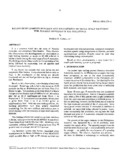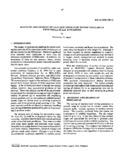Perlihatkan publikasi sederhana
Comparative analysis of small-scale aquaculture industry in three Southeast Asian countries
| dc.contributor.author | Matsuura, Tsutomu | |
| dc.contributor.editor | Nakamura, Koji | |
| dc.coverage.spatial | Philippines | en |
| dc.coverage.spatial | Thailand | en |
| dc.coverage.spatial | Malaysia | en |
| dc.coverage.spatial | Southeast Asia | en |
| dc.date.accessioned | 2023-08-29T02:28:27Z | |
| dc.date.available | 2023-08-29T02:28:27Z | |
| dc.date.issued | 2007 | |
| dc.identifier.issn | 1341-710X | |
| dc.identifier.uri | http://hdl.handle.net/10862/6474 | |
| dc.description.abstract | In many Southeast Asian countries, coastal fishing villages are increasingly encouraging their inhabitants to start small-scale aquaculture as a way of reducing the labor involved in fishing and diversifying their sources of income. This study aims to conduct a comparative analysis of small-scale aquaculture in the Philippines, Thailand and Malaysia (hereinafter referred to as the ‘three countries’). Aquaculture plays a leading role as a secondary source of income in the Philippines, and is both a primary and secondary source of income in Thailand and Malaysia. Even if a highly productive method of aquaculture were introduced in the Philippines, however, it would not see much uptake because it would be prone to damage by typhoons. Thailand and Malaysia, however, which are unaffected by typhoons, have rapidly increased their mussel production thanks to the active introduction of highly productive aquaculture methods. Our search of the points that developing areas in the three countries have in common revealed that many people started small-scale aquaculture after the mid-1990s in advanced areas, and that most small-scale aquaculture operators say that shellfish are easy to culture and want to continue in the business. | en |
| dc.description.sponsorship | This study was carried out collaboration with the Southeast Asian Fisheries Development Center/Aquaculture Department (SEAFDEC/AQD) in the Philippines, Kasetsart University and SEAFDEC/Secretariat in Thailand, the Fisheries Research Institute (FRI) in Malaysia and the Japan International Research for Agricultural Science (JIRCAS). We express our thanks to all of them for their efforts and assistance. | en |
| dc.language.iso | en | en |
| dc.publisher | Japan International Research Center for Agricultural Sciences | en |
| dc.relation.ispartofseries | JIRCAS Working Report; No. 56 | |
| dc.subject | fishery production | en |
| dc.title | Comparative analysis of small-scale aquaculture industry in three Southeast Asian countries | en |
| dc.type | Book chapter | en |
| dc.citation.spage | 145 | en |
| dc.citation.epage | 151 | en |
| dc.citation.bookTitle | Sustainable Production Systems of Aquatic Animals in Brackish Mangrove Areas (2005) | en |
| dc.subject.asfa | small-scale aquaculture | en |
| dc.subject.asfa | comparative analysis | en |
| dc.subject.asfa | aquaculture | en |
| dc.subject.asfa | coastal fishing communities | en |
| local.subject | small-scale aquaculture | en |
| local.subject | coastal inhabitants | en |
| local.subject | advanced/developing areas | en |
| local.subject | primary/secondary source of income | en |
Files in this item
| Files | Size | Format | View |
|---|---|---|---|
|
There are no files associated with this item. |
|||
Publikasi ini ada di koleksi berikut
-
Books and Book Chapters [123]



